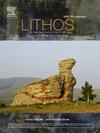Mechanisms of shear zone development in Krossøy, the Bergen Arcs, Norway
IF 2.9
2区 地球科学
Q2 GEOCHEMISTRY & GEOPHYSICS
引用次数: 0
Abstract
The island of Krossøy in the Bergen Arcs, southwestern Norway, provides an ideal geological setting to study the mechanisms of grain size reduction in plagioclase during shear zone development. The transition from a granulite facies anorthosite to mylonitic textures under amphibolite facies conditions is investigated through field observations, petrographic analysis, electron microprobe analysis, and electron backscattered diffraction (EBSD) techniques. Initial ductile deformation, evidenced by complex twinning and intragrain misorientation, leads to strain hardening and subsequent brittle fracturing. This results in grain size reduction primarily through fragmentation, forming a bimodal grain size distribution. Syntectonic recrystallization produces compositionally similar neoblasts. Subsequent interactions with fluids induce compositional recrystallization, leading to further grain size reduction and the formation of zoned plagioclase grains. These processes highlight the critical role of fluid-mediated recrystallization in shear zone development and strain localization. The spatial variation in deformation and hydration stages across Krossøy is attributed to both mechanical anisotropy and chemical reequilibration driven by fluid pathways. These findings enhance our understanding of the interplay between mechanical anisotropy, brittle failure and fluid infiltration in the lower crust, providing insights into the conditions that facilitate the formation and evolution of shear zones in the Bergen Arcs.
求助全文
约1分钟内获得全文
求助全文
来源期刊

Lithos
地学-地球化学与地球物理
CiteScore
6.80
自引率
11.40%
发文量
286
审稿时长
3.5 months
期刊介绍:
Lithos publishes original research papers on the petrology, geochemistry and petrogenesis of igneous and metamorphic rocks. Papers on mineralogy/mineral physics related to petrology and petrogenetic problems are also welcomed.
 求助内容:
求助内容: 应助结果提醒方式:
应助结果提醒方式:


